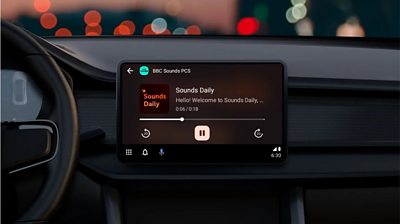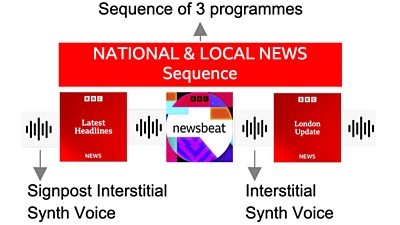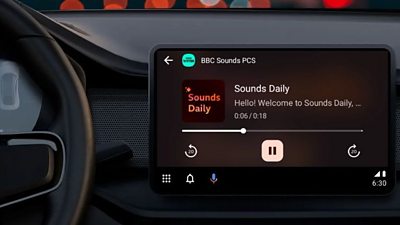In this series we've outlined how Sounds Daily could improve the in-car audio experience for drivers, combining the ���˿���’s existing technical infrastructure, R&D innovations and emerging technology to help drivers find something enjoyable to listen to.
Sounds Daily would give drivers one less thing to think about while driving and provide an entertaining personalised mix of news, sports and on-demand spoken word and music programmes. These are algorithmically and editorially picked and presented in a sequence tailored to the individual. The duration and number of the sequences created can vary, so drivers always have an audio companion no matter how long or short their journey. Programmes and sequences are interspersed by an AI generated synthetic voice, signposting content and linking programmes, while also presenting contextual details relevant to each individual and their journey.
�ċIn this instalment, we delve into a foundational aspect of the Sounds Daily concept - audio personalisation. Our trial investigated personalisation through various means, including automated and human-curated recommendations, and the order content plays back. We also explored beyond content to see how actions and responses can progressively improve the experience. Can this type of enhanced and nuanced personalisation lead to increased user engagement and foster a habit of daily use?

Personalised content recommendations�ċ
When an experience feels personal, relevant, and addresses a person’s needs, then people are more like to use it and the likelihood of habitual use increases. So designing an experience with personalisation at its core can be incredibly powerful.�ċ
�ċOur first approach was to personalise Sounds Daily’s content recommendations. We gave drivers what they might enjoy based on their listening history, how long they listened, and what they avoided, along with other data points. We used this as a filter to apply to all content available via the ���˿��� Sounds app. This created a pool of potential programmes that could played while in the vehicle.�ċ
Programme sequences
�ċConsciously or not, people select what to listen to based on a physiological need. For example, if someone needs to relax, they will look for relaxing programmes to listen to. We pick genres or programmes that align with our individual interests and preferences, where or how we’re listening, or our mood - so what relaxes one person might be different for another. Listeners will continue with a programme until their need is satisfied when they may switch off, choose a programme that meets a different need, or the process is interrupted by a change in circumstances - for example, a journey coming to an end. Selection does not occur in a vacuum, and each programme is part of a larger series - or sequence - with different needs being met at different moments.
�ċWith this in mind, our next approach was to arrange programmes in sequences and present them in personalised playlists designed to appeal to these individual preferences, that were sensitive to the in-car listening context.�ċ
�ċAs every Sounds Daily listening session is essentially a sequence of programmes, personalisation needs to cover both the selection of the content and sequencing of the content. Each sequence contains three programmes classified by the type of content (such as news, sport, music) and these sequences can be linked to create longer or shorter playlists as needed.


Playlists�ċ
�ċOur trial playlists were relatively broad, featuring or omitting certain types of content. For example, one playlist reflected a common desire to feature no news. Another playlist was filled with music programmes. We could manually create fairly nuanced playlists from the classifications of content, bringing certain nodes and shows to the fore and in future editors could curate or automate this process. We saw how drivers reacted to the playlists they received and how their listening altered or aligned with what they were presented. As drivers use the system more, we hope to understand what content appeals and potentially offer playlists that meet different user needs, but more personal data would be required to do this.�ċ
�ċBeyond recommendations - the experience that feels personal�ċ
�ċAt its most basic, the Sounds Daily synthetic voice provides a sense of flow to sequences, but we explored personalisation in several other ways.�ċ
To add a personal touch, drivers receive a greeting using their submitted name and the current time, making the experience feel more immediate and individualised. Elements of each driver’s personal data, contextual data (for example, location) and other metadata sources can be spoken to make the experience more useful and interesting.�ċ
�ċFor the introduction to each sequence, the AI crafts engaging links and lead-ins using metadata about the content like titles, genres, and presenters to let drivers know what shows are coming up. Between programmes, linking messages smoothly transition drivers from one programme to the next, managing the passage between different genres and tones, tying everything together.
�ċThese messages to the listener, the wording, tone, feel and amount of variation can all be prescribed through instructions to the AI known as prompts. The synthetic voice then vocalises its responses, providing spoken introductions to what’s on the playlist. Visual distraction and interaction can pose a risk to drivers, and so the spoken messages make the Sounds Daily experience more navigable in an in-car environment.�ċ
That being said, drivers are only more empowered when they hear and are receptive to the synth voice used, and so we also explored the type of voice a user would hear. This is another important part of the personalisation picture. The synthetic voice can be customised to be more human or robotic, old or young, male or female, or to emulate a trusted or desired person. However, in our trial, we only used male and female voices to see what the audience response was like, though in the future we could customise the voice and presentation style with individual driver preferences.�ċ
The dynamic nature of personalisation�ċ
�ċDesigning personalised experiences is challenging, mainly because of the number of dynamic elements that feed into it. Each element mentioned here can be tailored to the individual, but this is a continual, iterative process building on things like the user’s explicit actions (such as skipping content) or implicit actions (their listening duration or the time of day). These data points are just some of those recorded and the user’s experience of Sounds Daily can evolve and be refined by incorporating these types of data.�ċ As we come to understand what these data points mean for each user, we can use this information to feed into the personalisation loop that would continually align the Sounds Daily experience to the user.
Conclusion�ċ
�ċOur aspiration for Sounds Daily is to provide a seamless, one-click solution for drivers’ content needs. This relies heavily on trust. Drivers must believe that the content recommendations and sequencing meet their needs without excessive interaction.�ċ
�ċDuring our trial, we tracked metrics like journey start times, listening durations, program displays, skip instances, and the most skipped programmes and genres. This helped us craft new playlists with the goal of aligning more closely with the driver’s preferences. Although we manually managed this process in the trial, it could be automated in future, leading to fully automated content selection and sequencing. There is potential for this automation to improve the system’s ability to interpret driver cues and refine the overall listening experience.�ċ
�ċIn our trial, we investigated the interplay between explicit user actions, such as skipping, and implicit personalisation, where the system adjusts to user needs either automatically or through human input. We learned that users are aware the system evolves over time and are generally willing to allow some initial adjustment. However, they expect the system to be adequately personalised from the beginning and not just offer a random mix of content.
-

What is Sounds Daily?
Our trial of in-car, personalised short & long form audio based on listening history. -

Beyond recommendations
More than just personalisation - AI generated synthetic voices greet drivers and introduce programmes. -

Building our trial
Creating the recommendations and generating the synthetic voices with prompt templates. -

Feedback and conclusions
Audience feedback has been important, helping us shape the trial.

